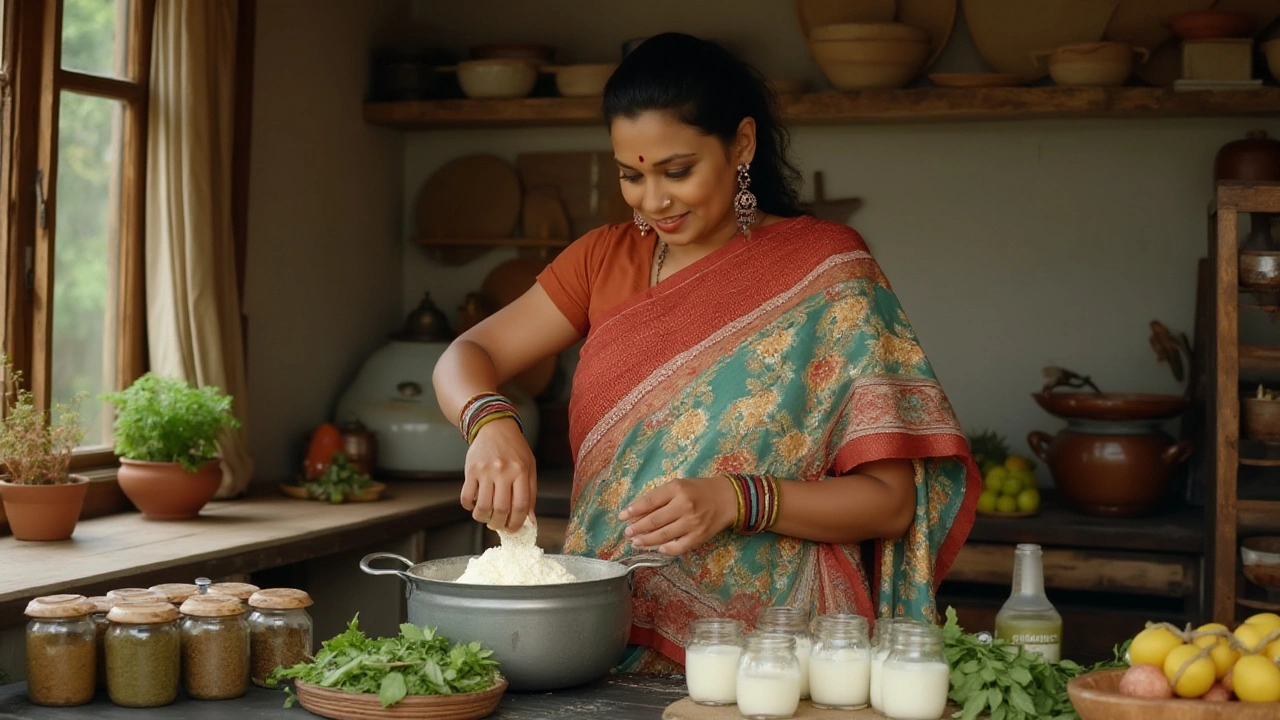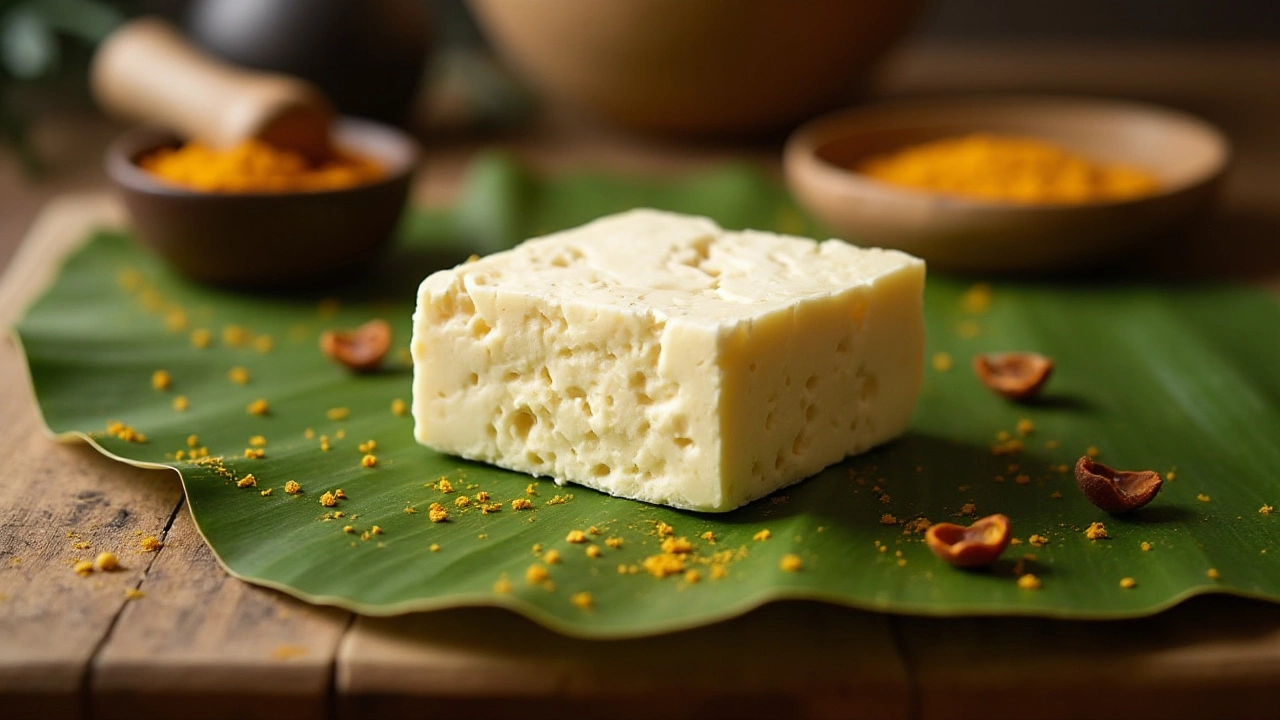Is Expired Milk Safe for Homemade Paneer and Yogurt?
 Jan, 13 2025
Jan, 13 2025
We've all been there—standing in front of the fridge, holding a carton of expired milk, and wondering if it's possible to salvage it for culinary purposes. While it might seem counterintuitive, expired milk can sometimes be just the ingredient you need for delicious homemade yogurt or paneer.
Before you dismiss this idea, let's explore how the natural fermentation process works and how a slightly expired product might still hold culinary potential. Behind the scenes, fermented dairy wonders like yogurt rely on bacterial cultures, which convert lactose into lactic acid, giving these foods their characteristic tang and texture.
Still, it isn't just about tossing any old milk into a pot. To ensure safety and a successful transformation, there are key signs and tips to keep in mind. A sour smell isn't always bad, but when mixed with curdling and discoloration, it's best to steer clear. Trust your senses, and when in doubt, stick to the clear guidelines discussed in this guide.
- Understanding Expired Milk
- Fermentation and Safety
- Tips for Making Yogurt and Paneer
- Sustainability and Waste Reduction
Understanding Expired Milk
The idea of using expired milk might sound unsettling at first. Yet, before you discard it at the slightest sign of a sour smell, it's important to delve deeper into what 'expiration' truly means for dairy. Many find that the date stamped on milk cartons—often labeled as 'sell-by' or 'use-by'—does not indicate an instantaneous transformation from edible to toxic. Instead, it's more of a guide for retailers about when to rotate stock. Crucially, the formulation and storage conditions factor significantly into how quickly milk spoils or if it remains usable past its stamped date.
In the case of homemade yogurt, understanding the role of bacterial cultures can offer insight into using expired milk safely. These bacterial strains consume lactose and, in turn, produce lactic acid, which can naturally preserve dairy products. Such fermentation results in a tangy taste, making yogurt not just a practical solution for milk preservation but also a delightful homemade treat. In fact, quoting a food science expert, "Fermentation does not only convert lactose; it actually suppresses the growth of spoilage microbes, allowing some latitude in the freshness of the milk used."
However, not all forms of expired milk are safe or ideal for use. There are visual and tactile checks that one must undertake. Visible mold or radical changes in color are clear red flags. On occasions where milk becomes thick and clumpy but lacks an off-putting odor, it may still be viable for fermentation—but it's often better to err on the side of caution. A structured checklist may help:
- Check for off-odors. Slight sourness is tolerable, but foul odors are not.
- Inspect the milk's texture and clarity. Clumps and a brownish hue can mean spoilage.
- Trust your taste (with caution): an unpleasant taste signifies it's beyond redemption.
On the scientific side, many experts note that milk stored just a few degrees below its ideal temperature accelerates spoilage. Thus, consistent refrigeration is key for longevity and potential secondary uses. Interestingly, a study might show that milk can last approximately 2-3 days longer than the printed date if stored at an optimal 37°F rather than the typical 40°F found in many home refrigerators, presenting a subtle yet profound impact.

Fermentation and Safety
Fermentation in dairy products like yogurt is a fascinating process, where friendly bacteria work their magic on milk, turning it into a tangy and creamy delight. These bacteria, primarily lactobacilli and streptococci, consume lactose, the sugar in milk, and convert it to lactic acid. This not only gives yogurt its distinct flavor but also lowers the pH, creating an environment that's inhospitable to harmful bacteria. This process is precisely why the concept of using expired milk to make homemade yogurt isn't as reckless as it sounds. The acid produced acts as a preservative, adding a layer of safety.
But before you start whipping up your next batch of yogurt with that forgotten carton of milk in your fridge, it's essential to differentiate between spoilage and proper fermentation. Mildly expired milk, which has developed a slightly sour smell without drastic curdling or discoloration, can sometimes still be saved for fermentation. It's a different story if your milk looks or smells overly unpleasant—it might be breeding harmful bacteria that even the fermentation process cannot neutralize. In the cheese-making community, there is a saying: "If the milk smells like it's from hell, it won't gel." In a similar vein, yogurt-maker Brian Richter, author of 'Cultured Milk: A Beginner's Journey,' advises,
The margin between good ferment and a food safety issue is narrower than one might think. Always err on the side of caution.
Dairy scientists have found that specific methods can enhance the safety and effectiveness of using expired milk. Boiling the milk before fermentation can eliminate some undesirable pathogens, giving your starter cultures a fighting chance. This technique, combined with scalding, is particularly useful if you're uncertain about the milk's quality. Once boiled, letting the milk cool to a sufficiently warm temperature before adding starter cultures ensures optimal bacterial activity. Adhering to these practices not only minimizes risks but can also result in superior texture and taste.
For those concerned with food waste, utilizing expired milk can be part of a sustainable lifestyle, provided you take the right precautions. With USDA statistics noting that approximately 30% of food is wasted, finding innovative ways to utilize food nearing its expiration can have a noticeable impact. Not only does this practice help reduce your ecological footprint, but it also encourages creativity in the kitchen. A batch of homemade yogurt made from milk past its prime can be the catalyst for an assortment of culinary ideas, such as smoothies, dips, and desserts, once you assure its safety through proper fermentation techniques.

Tips for Making Yogurt and Paneer
Making yogurt and paneer at home from expired milk is not only a cost-effective way to cut down on waste, but it can also be an enriching culinary experience. The key to success lies in recognizing milk that's just gone past its expiration date rather than milk that's truly gone sour or spoiled. To begin, it's crucial to assess the smell and appearance of your milk. If it has a slightly sour scent, without any lumps or odd colors, you're likely safe to proceed. However, if it smells rancid or has a greenish hue, it's best to avoid using it for any cooking endeavor.
To start making yogurt, scald the milk by heating it gently until it's just about to boil—then cool it down to room temperature. This step not only kills potential harmful bacteria but also sets the stage for your introduced cultures to triumph. After cooling, stir in a small amount of live culture yogurt to jump-start the fermentation. Wrap it up in a towel and let it sit in a warm place for about 8 to 12 hours, depending on how tangy you want your yogurt to be. Once done, refrigerate it before enjoying.
When making paneer, bring the milk to a boil and slowly add an acidic agent like lemon juice or vinegar, stirring steadily until the milk starts to curdle. Once curdled, remove it from the heat and allow it to sit for about 10 minutes. This helps the curds set fully, giving you a richer texture. Strain the curds through a cheesecloth and rinse them under cold water to remove the acidic residue. Tie up the cheesecloth to drain any remaining whey, hang it for an hour or so, and then press it lightly to shape your paneer block.
A few tricks can elevate your homemade creations. For richer homemade yogurt, consider using whole milk. This gives a creamier consistency, which makes for a delightful spoonful straight from the pot. As for paneer, a sprinkle of salt before tying up the curds can enhance the flavor. Keep an eye on the boil too, as overheating could turn the texture rubbery. According to culinary expert Jared Stone, "Paneer should always be soft and rich, with a gentle spring, like the pillow of a good night’s sleep."
An interesting fact to note is how this process contributes to sustainability. Statistics suggest that a significant portion of milk is wasted globally due to misunderstanding expiration dates. By using slightly expired milk, you're not only creating delicious treats but also doing your part for the environment. Try using this technique for small batches first to perfect your method before scaling up to larger productions.
Incorporate these tips and reap the rewards of fresh, homemade paneer and yogurt. There's something deeply satisfying about creating something so traditional and wholesome, turning common kitchen waste into delightful meals. Your journey into homemade dairy products starts here, where curiosity meets sustainability, beautifully harmonized by the natural science of fermentation.

Sustainability and Waste Reduction
In today's world, where sustainability is increasingly at the forefront of our minds, finding ways to reduce waste in the kitchen can have a significant impact. One creative strategy is to utilize expired milk in innovative ways rather than simply discarding it. With over 80% of a typical household's food waste comprising edible items, according to the USDA, rethinking how we use ingredients like milk can help in mitigating environmental impacts. This becomes particularly compelling when considering the production costs and resources tied up in dairy farming, from land use to water consumption. By turning potentially wasted milk into homemade delights such as yogurt or paneer, we can contribute to this ongoing conservation effort.
When you intercept milk before it truly spoils, you can harness its potential through fermentation or cheese-making processes. It isn't just about reducing waste; it's also wrapping yourself with the comfort of knowing you’re making responsible choices. As food writer Bee Wilson poignantly noted,
“Reducing waste is a question of making the most of the abundance we already have.”This ethos plays out beautifully in the kitchen, where families can engage with sustainable practices without feeling overburdened. Importantly, choosing to transform expired milk at home can also spark creativity and inspire healthier cooking with fewer preservatives and additives compared to store-bought options.
Aside from its environmental and health benefits, using expired milk also makes economic sense. The Food and Agriculture Organization reports that reducing food waste cuts food expenses by nearly 10% for average households, exacting a noticeable impact on your wallet over time. Utilizing expired products means one less trip to the grocery store and fewer dollars spent replacing unused spoiled milk. Consequently, embracing these practices translates not only to cooking innovation but also financial savings, aligning fiscal responsibility with eco-consciousness. Imagine a world where less ends up in landfills, and more ends up on our tables as delicious, homemade fare.
